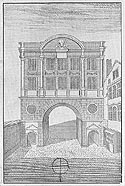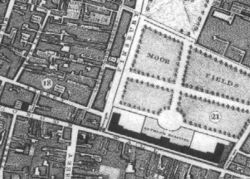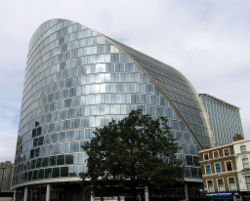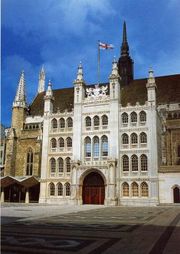Moorgate
2007 Schools Wikipedia Selection. Related subjects: Geography of Great Britain
Moorgate was one of the minor gates of the old London Wall. Though the gate itself was demolished in 1761, the name survives as a major street in the heart of the City of London. The street connects the city to Islington, and was constructed around 1846 for the formation of new approaches to London Bridge.
The name "Moorgate" derives from the surrounding area of Moorfields, which was one of the last pieces of open land in the city. Today this region is a financial centre, and is home to several of the United Kingdom's major investment and commercial banks. The street also showcases historic and contemporary office buildings, including the Guildhall and the Moorhouse.
The Moorgate station on the London Underground is widely remembered for the Moorgate tube crash of 1975. In the incident, a train terminating at the station failed to stop and crashed into a brick wall, and 43 people were killed. This resulted in systems being installed on the Underground which automatically stop trains at dead-ends, which have become known as Moorgate control.
History
The earliest descriptions of Moorgate date from the early 15th century, where it was described as only a postern in the London city wall. Located between Bishopsgate and Cripplegate and leading to a moor known as Moorfields, it was not one of the larger or more important of the city gates.
In 1415 an ordinance enacted that the old postern be demolished. It was replaced with a newer and larger structure located further to the west, which included a wooden gate to be shut at night. This gate was enlarged again in 1472 and 1511, and then damaged in the Great Fire of London. Although the city gates had ceased to have any modern function apart from decoration, it was replaced along with Ludgate, Newgate, and Temple Bar with a stone gate in 1672.
Moorgate was demolished with all the other London city wall gates in 1761, and the resulting stone was sold for £166 to the Corporation of London to support the starlings of the newly widened centre arch of the London Bridge. Little Moorgate was a gate opposite Little Winchester Street leading into Moorfields. It was demolished by 1755, however it gave its name to a street taken down by the construction of the railways.
The Moorfields were one of the last pieces of open land in the City of London. The fields were divided into three areas: the Moorfields proper, just inside the City boundaries, north of Bethlem Royal Hospital (also known as Bedlam, the world's oldest psychiatric hospital), and Middle and Upper Moorfields (both also open fields) to the north. Much of Moorfields was developed in 1777 and turned into present day Finsbury Circus.
Today, the name survives in the name of the Catholic parish of St. Mary Moorfields; Moorfields the short street parallel with Moorgate; and Moorfields Highwalk, one of the pedestrian "streets" at high level in the Barbican Estate.
In addition, the London Dispensary for curing diseases of the Eye and Ear was founded on the Moorfields in 1805, and evolved to become the present Moorfields Eye Hospital, which is now located on City Road (known popularly from the second verse of the nursery rhyme Pop Goes the Weasel), and is close to Old Street station.
Moorfields was the site of the first hot air balloon flight in England, when Italian Vincenzo Lunardi took off on the afternoon of 15 September 1784. Lunardi flew in a hydrogen balloon from the area of the Honourable Artillery Company near Moorfields (where it still is to this day, occupying a site next to City Road). The ascent took place in front of 100,000 spectators as well as the then Prince of Wales, George, Duke of Cornwall. The envelope of the balloon was made of oiled silk, and had a diameter of 33 ft (10 metres) which resulted in a volume of 18,200 cubic feet (515 m³). Due to the size of the balloon, it took all of the previous evening and early morning to fill it. Lunardi first landed at Welham Green (North Mymms), Hertfordshire, 13 miles (21 km) north of London (where the landing is commemorated with a stone, at a location now known as Balloon Corner) and then continued his flight to land at Ware, Hertfordshire after flying a total of 24 miles.
Moorgate Street and neighbourhood
The contemporary dual carriage street of Moorgate runs north from Princes Street and Lothbury near the location of the Bank of England, past London Wall and the location of the old gate, and then continues north. It is located inside the London EC2 postal district. After leaving the City of London in the direction of the Borough of Islington, the street is known as Finsbury Pavement, which at one time was known as Moor Fields Pavement, and then City Road. The street was constructed around 1846 as one of the new approaches to London Bridge. While the street was formally known as "Moorgate Street", the street part of the name eventually fell out of use.
The street is lined with offices of several major commercial banks and investment banks. A new commercial development on Moorgate, known as Moorhouse, is scheduled to open in 2005. The building is located at the corner of Moorgate and London Wall, and was designed by Foster and Partners. The building has 28,000 m² of office space in 19 storeys, and is built in the location of a smaller office building built in the 1960s known as Moor House. The building incorporates part of Crossrail's new station and ticket hall serving Liverpool Street and Moorgate.
There is a campus of the London Metropolitan University, formerly a part of the London Guildhall University, on Moorgate. The campus houses its business school, a library, and other administrative facilities. There is a small side street to the east off of Moorgate, known as Moorgate Place. It now connects to another side street known as Swan Alley, in turn connecting to Moorgate. The side street is the location of the Chartered Accountants' Hall, home of the Institute of Chartered Accountants in England and Wales,
The Guildhall is connected to Moorgate station via Bassishaw Highwalk. The Guildhall is the home of the Corporation of London and the centre of City government since the Middle Ages. Adjacent and internally connected to the Guildhall is the Guildhall Art Gallery, which houses the art collection of the City of London. It occupies a stone building in a semi- Gothic style which was completed in 1999 to replace an earlier building destroyed in 1941.
Finsbury Circus, an oval-shaped circus, branches east out of Moorgate, sitting on the site of the old Bethlem Hospital and part of Moorfields. The gardens in the centre of the circus occupy a 5,000 square metre (1.2 acres) plot enclosed by railings, and include the immaculate lawn of the City of London Bowls Club. Built in 1814, it is unusual amongst London's squares in being elliptical, with the major axis oriented west-east. According to the National Register of Historic Parks and Gardens, the garden is Grade II listed.
The London branch of the Bank of Tokyo-Mitsubishi is located at 12-15 Finsbury Circus. BP's headquarters were previously at 1 Finsbury Circus (it is now at 1 St. James' Square).
Moorgate is also the birthplace of John Keats, one of the principal poets in the English Romantic movement. Keats was born in 1795 in the Swan and Hoop Inn at 199 Moorgate, where his father was an ostler. The pub is now called "The John Keats at Moorgate", having previously been known as "The Moorgate Coffee House" and "The Moorgate", only a few yards from Moorgate station.



